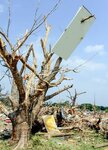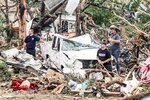





To this day, Tammy Mullins still finds glass when she gardens in her back yard. The shards trigger memories of that night when, in the blink of an eye, her life and so many others were shattered.
Some were ended.
Monday will mark the 10th anniversary of the EF4 tornado that decimated the Rancho Brazos neighborhood, including Habitat for Humanity homes, and damaged other areas. Six people were killed.
The whirlwind was the first deadly tornado event in Texas since the Piedras Negras-Eagle Pass tornadoes of 2007.
An EF4 tornado is a superstorm that has wind speeds between 166 mph and 200 mph. On April 25, 1994, an EF4 tornado slammed the Dallas suburb of Lancaster, leaving three people dead and almost 50 injured. Several families who attended the same church and lived in the same neighborhood sheltered in their laundry rooms and recited the Lord’s Prayer. They all survived, and their laundry rooms were all that remained of their homes.
On the night of May 15, 2013, there were actually two tornados in Hood County, according to the National Weather Service. One was the EF4 and the other was an EF1 that damaged 15 homes and one business in Pecan Plantation but caused no known injuries.
After the EF4 struck, 16 people were taken by ambulance to Fort Worth hospitals. Twenty-eight people with fractures and lacerations ranging from minor to severe went to Lake Granbury Medical Center. Half were admitted, while the other half were treated and released.
The tornado and its devastating impact on Hood County made international news. Then-County Judge Darrell Cockerham was interviewed on CNN and BBC. National, state and regional media descended on Hood County.
“It quickly became a national event, so we had lots of media,” Sheriff Roger Deeds said. “And Governor (Rick) Perry came with the Attorney General Abbott.”
Perry, along with Greg Abbott, who is now governor, toured Rancho Brazos and participated in a news conference held against a backdrop that looked like a war zone.
The EF4 struck with breathtaking speed that night, leaving residents of Rancho Brazos with little time to take cover. Hood County’s then-Emergency Management Coordinator, Ray Wilson, had been on the job just two weeks when a Code Red alert was activated to about 18,000 phones in Hood County at 8:03 p.m. that Wednesday night.
Moments later, between 8:10 and 8:20 p.m., according to Deeds, the tornado hit.
“IT’S HERE!”
Mullins, who lives on Highview Drive in the Habitat section of Rancho Brazos, was on her back porch visiting with friends, a man named Wade and a woman named Sheila. Her disabled son Cody, 20 at the time, and her daughter Jessica, then 14, were there, as was the daughter of a neighbor who worked for the Sheriff’s Office.
“We’re sitting outside on the porch, everybody’s just talking, the kids are playing (with) chalk on the driveway, and it started getting dark,” Mullins recounted.
The neighbor who worked for the HCSO phoned and told them to take cover immediately. A tornado was “coming across the lake.”
Suddenly, there was hail, Mullins said. At first, it was pea sized but then it became the size of softballs. And it was spiked. She still has a picture on her cell phone of one of the monster hail stones.
Mullins and the other adults rushed to move their cars to the other side of the street hoping that large trees there might protect their vehicles from the hailstorm. Then they all dashed inside Mullin’s’ house.
“And then, it was just there,” Mullins recounted. “I mean, we’re looking at it.”
The tornado was headed straight down the narrow street.
Cody, who has “sensory issues,” Mullins said, didn’t understand the danger. He thought the tornado was “the coolest thing he had ever seen,” his mother said, and was laughing and “bouncing around the hallway.”
“I literally had to tackle him,” Mullins said.
As Mullins threw her body on top of her disabled child, she heard Sheila yell, “It’s here!”
Simultaneously, every window in the house blew out, sending glass everywhere.
“I was praying,” Mullins recounted. “I was praying God, please help me save these children.”
Although her home sustained major damage, the most destruction occurred on the other side of the street, where there were mobile homes.
The aftermath “looked like a war zone,” Mullins said, echoing words that the sheriff also used to describe the scene.
The trailers across the street were gone. Propane tanks spewed and downed power lines sparked. Some of the roofs that remained were impaled by two-by-fours. Vehicles, their windows broken, were tossed as if they weighed nothing. Mangled sheet metal hung from tree branches after being hurled there. Debris was everywhere.
Mullins and those with her assisted the wife of a truck driver who lived nearby. Mullins said the woman was “severely injured” with a leg wound.
First responders arrived and directed everyone to head to the American Legion Post a short distance away on Davis Road.
From there, buses transported tornado victims to other locations. Mullins said that she and her family were initially taken to Oak Woods School but emergency workers there said there was no more room. The bus then transported them to a shelter set up at First Christian Church of Granbury near Tractor Supply on U.S. Highway 377.
All over the county, those affiliated with emergency services, churches, and nonprofits sprang into action.
“WE KNEW IT WAS HEADING FOR US”
At another house in the Habitat neighborhood, on Tumbleweed Lane, Angela and Thomas Nettles also raced against time to save children from the powerful force headed their way.
The couple was home with their three kids, two daughters and a son, and a couple of their sons’ friends. The boys had been playing baseball in the yard. Angela Nettles told the kids that they would not attend church that evening because there was a severe thunderstorm warning.
The severe thunderstorm warning turned into a Code Red tornado alert.
“(It was) extremely scary because we knew it was heading for us,” Angela Nettles said.
Nettles said that she and her husband told the kids to get the family pets, two dogs and a cat, and go into the bathroom. At that time, the couple’s oldest daughter was 18, their middle daughter was 15, and their son was 12.
The kids made it into the bathroom OK, but the change in pressure brought by the tornado made Angela and Thomas’ efforts to join them more difficult. By that time, the door had become “vacuum sealed,” Nettles said.
Thomas, who was shirtless, sustained scratches on his back but was able to get through the bathroom door. Nettles was blown into the bathroom, landing on her knees with the imprint of the home’s thermostat on the back of her right arm.
“They were scared. They were screaming for me,” Nettles said of her children.
Somehow, they managed to get the bathroom door closed.
AFTERMATH
Like the group from the Mullins household, the people in the Nettles group, too, survived the tornado’s assault and made their way to the American Legion Post.
During the months when work was done to restore her home, Mullins and her children lived with Sheila. The Nettles family lived with relatives. Due to drainage issues in their backyard on Tumbleweed Lane, the Nettles’ home was rebuilt in a different location within the Habitat community, on Sundown Trail.
The families are doing well, though some emotional scars remain. There is more apprehension this time of year. More caution when storms are in the forecast.
Based on reporting by the Hood County News in 2013, 250 people were transported out of Rancho Brazos that night, either by private vehicle, ambulances, or buses.
Out of approximately 110 homes in Rancho Brazos, all but 13 sustained damage. Seventeen had major damage and 36 were destroyed.
Among the homes destroyed was Habitat’s 66th home, which had been scheduled for dedication in just three days, on Saturday, May 18.
Ten years later, the only damage that remains is that which cannot be fixed by hammer and nails.
Mullins and Nettles don’t dwell on that, though. They focus instead on how the community came together and made sure that everyone who suffered was made whole.
“It was amazing,” Nettles said of the outpouring of generosity and caring from so many in the community. “They were coming by for weeks afterwards asking if there was anything we needed.”
New trees were planted in yards to replace ones that had been uprooted, and six trees were planted in the neighborhood in memory of those who died that night, Nettles said. The Rancho Brazos community is even closer than before, thanks in no small part to the Rancho Brazos Community Centers and initiatives made possible by generous donations and the dedication of staff and volunteers.
“So,” Nettles said, reflecting on the current state of Rancho Brazos, “a lot of good has come from it.”